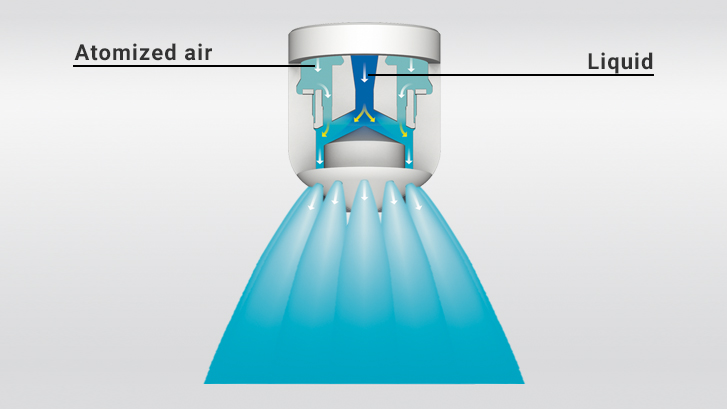Table of Contents
Introduction
In an era marked by rapid technological advancement and innovation, atomization technology stands out as a transformative force reshaping manufacturing processes across industries. From pharmaceuticals to aerospace, atomization technology plays a pivotal role in the production of a wide range of products, driving efficiency, precision, and sustainability. In this comprehensive exploration, we delve into the principles, applications, impact, recent advancements, and future prospects of atomization technology, illuminating its profound influence on modern manufacturing.
Principles of Atomization Technology

Atomization technology revolves around the fundamental process of breaking down bulk materials into fine particles or droplets. This process is achieved through various techniques, including mechanical, thermal, and pneumatic methods. For instance, spray drying involves the conversion of liquid feedstocks into dried powders through the application of heat and atomization. Similarly, spray coating utilizes atomization to apply thin, uniform layers of coating materials onto substrates. Regardless of the specific method employed, atomization technology enhances the surface area, dispersibility, and reactivity of materials, unlocking new possibilities for product development and manufacturing.
Applications Across Industries
Atomization technology finds diverse applications across a multitude of industries, each benefiting from its unique capabilities and advantages. In the pharmaceutical sector, atomization technology is integral to the production of inhalable medications, oral solid dosage forms, and injectable formulations. By atomizing drug solutions or suspensions, pharmaceutical manufacturers can achieve precise particle size distribution and drug delivery profiles, enhancing therapeutic efficacy and patient compliance.
In the food and beverage industry, atomization technology facilitates the creation of powdered ingredients, encapsulated flavors, and instant beverage mixes. By atomizing liquid food ingredients or solutions, food manufacturers can enhance shelf stability, improve solubility, and create innovative product formulations with extended storage life and enhanced sensory attributes.
In the aerospace and automotive sectors, atomization technology plays a critical role in the production of advanced materials, such as metal powders for additive manufacturing and ceramic powders for thermal barrier coatings. By atomizing molten metal or ceramic feedstocks, manufacturers can produce fine powders with tailored properties, enabling the fabrication of lightweight, high-performance components for aerospace engines, automotive transmissions, and industrial turbines.
Impact on Manufacturing Processes
The integration of atomization technology into manufacturing processes has profound implications for efficiency, quality, and sustainability. By producing materials in finely divided forms, atomization technology enables greater control over particle size, shape, and distribution, resulting in products with enhanced performance characteristics. For example, in pharmaceutical manufacturing, atomization technology allows for the precise control of drug particle size, enabling the development of controlled-release formulations with optimized bioavailability and therapeutic efficacy.
Additionally, atomization technology offers advantages such as reduced waste, lower energy consumption, and increased process flexibility. For instance, in the production of powdered food ingredients, atomization technology minimizes product loss and degradation, leading to higher yields and lower production costs. Similarly, in the aerospace industry, atomization technology enables the fabrication of complex geometries and near-net-shape components, reducing material waste and machining costs associated with traditional manufacturing methods.
Recent Advancements and Innovations
Recent advancements in atomization technology have focused on enhancing process efficiency, product quality, and material performance. One notable area of innovation is the development of additive manufacturing techniques utilizing atomized metal powders. By atomizing metal feedstocks and employing advanced 3D printing technologies, manufacturers can produce complex, high-performance components with unparalleled precision and functionality.
Another area of innovation is the utilization of computational modeling and simulation tools to optimize atomization processes. By leveraging computational fluid dynamics (CFD) simulations and finite element analysis (FEA), researchers can gain insights into fluid dynamics, particle trajectories, and heat transfer phenomena during atomization, leading to improved process control and product quality.
Furthermore, advancements in material science have led to the development of novel feedstocks and alloys suitable for atomization. For example, researchers have explored the use of advanced alloys, such as titanium aluminides and nickel-based superalloys, for aerospace applications. By atomizing these advanced materials, manufacturers can produce powders with tailored microstructures and mechanical properties, enabling the fabrication of lightweight, high-strength components for aerospace and automotive applications.
Future Prospects and Emerging Trends
Looking ahead, the future of atomization technology is filled with promise and potential. Emerging trends in atomization technology include the development of multi-material atomization processes, enabling the fabrication of hybrid structures with tailored properties and functionalities. Additionally, advancements in nanotechnology and biotechnology are driving the development of novel atomized formulations for drug delivery, food fortification, and cosmetic applications.
Furthermore, the adoption of atomization technology in emerging markets, such as additive manufacturing and energy storage, is expected to fuel growth and innovation in the coming years. With increasing demand for lightweight materials, high-performance components, and sustainable manufacturing solutions, atomization technology is poised to play a central role in shaping the future of manufacturing across industries.
Conclusion
In conclusion, atomization technology represents a cornerstone of modern manufacturing, driving innovation, efficiency, and sustainability across industries. By harnessing the power of atomization to transform materials into finely divided particles or droplets, manufacturers can unlock new opportunities for product development, process optimization, and market differentiation. As atomization technology continues to evolve and advance, its impact on manufacturing processes and product innovation will only grow, paving the way for a future defined by precision, performance, and progress.
For More Information Please Visit These Websites Craiyon And Vecteezy